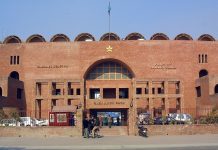DM Monitoring
Ishinomaki: An Olympic torch event in Japan drew hundreds of spectators on the day of the flame’s arrival on Friday, creating the type of packed gathering the government and Tokyo 2020 organisers have warned against to prevent coronavirus from spreading further.
About 500 people gathered in a jostling crowd to look at the flame and popular comedians taking part in a ceremony in Ishinomaki, 335 km (208 miles) north of Tokyo. The Greek part of the torch relay began last week, but a day later the remainder was cancelled to avoid attracting crowds. “It is not a good decision (to come here) but I am not sure if I will get another chance to see the cauldron,” Ishinomaki resident and teacher Kiyotake Goto, 44, told Reuters.
Earlier in the day, a plane carrying the torch from Greece arrived at Japan Air Self-Defence Force’s Matsushima airbase, which was devastated by a powerful earthquake and tsunami in 2011.
No spectators were present for the arrival ceremony at the base, where officials pledged the Tokyo 2020 Games will proceed despite mounting pressure to halt the world’s biggest sporting event due to the coronavirus pandemic.
“We originally planned to have children here to welcome the flame. But, prioritising their safety, we’ve decided to do without them,” Tokyo 2020 chief Yoshiro Mori said. “That was an agonising decision … We will do our utmost in preparing for a safe and secure event,” said Mori, a former prime minister. Organisers have repeatedly said the Games, due to run from July 24 to Aug. 9, will go ahead, but as the rapid spread of the virus brings the sports world to a virtual standstill, fears are growing that the Olympics may be postponed or cancelled.
“I think it’s impossible (to hold the Games). It’ll be a global issue if the virus spreads even further,” Koichiro Maeda, a 55-year-old company employee, told Reuters in downtown Tokyo.
The respiratory disease, which emerged in China late last year, has killed more than 10,000 people worldwide.
HEALTH CRISIS
Japan is grappling with pressure to avoid a health crisis among 600,000 expected overseas spectators and athletes at an event that could see $3 billion in sponsorships and at least $12 billion spent on preparations evaporate.
The plane with the torch arrived nearly empty after the Tokyo 2020 organising committee decided not to send a high-level delegation that was originally to have included Mori and Olympics minister Seiko Hashimoto.
“This is a tough time. I hope the torch relay will bring people vigour and hope,” Saori Yoshida, three-times gold-medal winning wrestler, told the welcome ceremony.
The flame will travel round the Tohoku region hit by the 2011 tsunami and earthquake, in what organisers call a “recovery flame” tour before the official kick-off ceremony in Fukushima on March 26. Organisers have urged the public not to crowd the relay route, cancelling many events along the way and restricting public access to others. Runners and staff will have their temperatures and health monitored, organisers said.
Some athletes, including reigning Olympic pole vault champion Katerina Stefanidi, said the International Olympic Committee’s decision to go ahead was putting their health at risk when entire countries have shut down to curb the virus.
The torch relay will begin at J-Village, a soccer training centre in Fukushima that served as an operations base for workers who battled triple meltdowns at the Fukushima Daiichi nuclear power plant after the 2011 tsunami.
It is due to pass many of Japan’s most famous landmarks over a 121-day journey to Tokyo’s Olympic stadium, including Mount Fuji, Hiroshima’s Peace Memorial Park and Kumamoto Castle.





